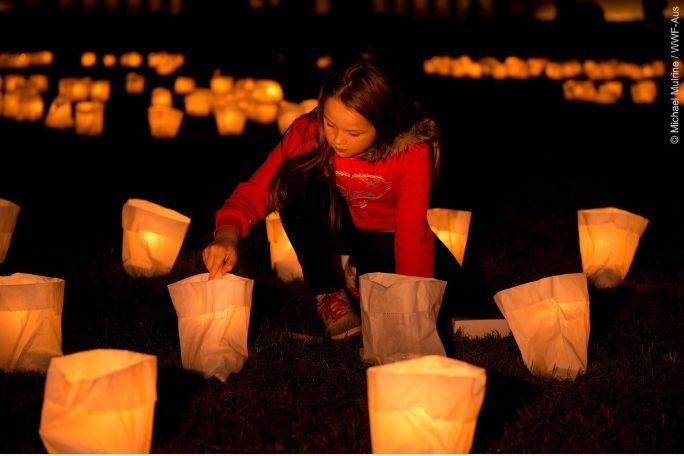Lesson summary
Students explore what they understand by the term ‘climate change’ and work together to define some of the actions we can all take to fight climate change. Following this they work as a class to identify how the headlines of news articles are written to draw in the reader. Using this knowledge they then work to create headlines for a range of climate change action news stories. Finally, students are asked to write their own story and headline about an action they are already doing to help stop climate change. This lesson may be followed by Earth Hour – Switch off to join the future – Years 3 & 4 – Lesson 2.
Essential questions:
- What is climate change? How does climate change affect our planet?
- What actions can we all take to limit climate change? Am I already doing some of these actions?
- Why do news stories have a headline? What are the tricks to creating a great headline for a news story?
- What is Earth Hour? How does Earth Hour spread news about climate change?
Lesson guides and printables
Lesson details
Curriculum Mapping
Australian Curriculum content descriptions:
Year 3 English
- Plan, draft and publish imaginative, informative and persuasive texts demonstrating increasing control over text structures and language features and selecting print, and multimodal elements appropriate to the audience and purpose (ACELY1682)
- Re-read and edit texts for meaning, appropriate structure, grammatical choices and punctuation (ACELY1683)
- Use software including word processing programs with growing speed and efficiency to construct and edit texts featuring visual, print and audio elements (ACELY1685)
Year 4 English:
- Plan, draft and publish imaginative, informative and persuasive texts containing key information and supporting details for a widening range of audiences, demonstrating increasing control over text structures and language features (ACELY1694)
- Re-read and edit for meaning by adding, deleting or moving words or word groups to improve content and structure (ACELY1695)
- Use a range of software including word processing programs to construct, edit and publish written text, and select, edit and place visual, print and audio elements (ACELY1697)
Syllabus outcomes: EN2-2A, EN2-3A.
General capabilities: Literacy, Critical and creative thinking, Personal and social capability.
Cross-curriculum priority: Sustainability OI.1, OI.6.
Relevant parts of Year 3 English achievement standards: Students create a range of texts for familiar and unfamiliar audiences. They choose vocabulary appropriate to the purpose and context of their writing, and they re-read and edit their writing, checking their work for appropriate vocabulary, structure and meaning.
Relevant parts of Year 4 English achievement standards: Students create structured texts to explain ideas for different audiences. They use language features to create coherence and add detail to their texts, and create texts that show understanding of how images and detail can be used to extend key ideas. They demonstrate understanding of grammar, select vocabulary from a range of resources and use accurate spelling and punctuation, re-reading and editing their work to improve meaning.
Unit of work: Earth Hour – Primary.
Time required: 60 minutes
Level of teacher scaffolding: – Medium – lead students in Place yourself along a line activity, guide students through other activities.
Resources required
- Device capable of presenting a website to the class
- Earth Hour – Stories from the past 10 years – Years 3 & 4
Skills
This lesson is designed to build students’ competencies in the following skills:
- Communication
- Community engagement
- Creativity
- Digital literacy
- Leadership
- Problem solving
- Social skills
Additional info
This lesson has been created in partnership with WWF-Australia. Earth Hour is the world’s largest community-driven climate change campaign. At the centre of Earth Hour is switching off lights to show a commitment to taking action.
Thousands of teachers use Earth Hour’s education program to enrich their curriculum and provide pathways for young people to create change in their world.
For the most up to date Earth Hour dates, times, and events, check here.


Welcome back!
Don't have an account yet?
Log in with:
By signing up to Cool.org you consent and agree to Cool's privacy policy to
store, manage and process your personal information. To read more, please see
our privacy policy here(Opens in new tab).
Create your free Cool.org account.
Many of our resources are free, with an option to upgrade to Cool+ for premium content.
Already have an account?
Sign up with:
By signing up to Cool.org you consent and agree to Cool's privacy policy to
store, manage and process your personal information. To read more, please see
our privacy policy here(Opens in new tab).